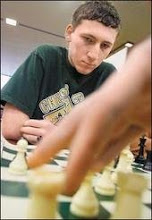Here is the 3rd round game:
Medrano-Madison
1. d4 e6 2. c4 b6 3. Nc3 f5 4. e3 Bb7 5. Nf3 Nf6
I probably needed to play the recommended ...Bb4 before this point, since the knight on c3 can become a pest.
6. a3 Nc6 7. d5!

This is a key break for white in this system. Had I played ...Bb4 like I am supposed to, d5 will never be as strong.
7. ...exd5 8. Nxd5!?
Stronger is actually 8. cxd5! Ne7 9. d6! which wrecks my structure. I had seen this when playing 7. ...exd5 but figured it to be the best I could hope for. Here I looked at many a variation before deciding what to do. 8. ...Nxd5 9. Qxd5 looks bad for me, as does 9. cxd5 with the same theme as the previous variation. So, I needed an alternative:
8. ...Ne4 9. b3 Ne7!
To rid myself of that pesky knight or force it to retreat from the superb d5 square.
10. Nxe7 Bxe7 11. Bb2 Bf6 12. Qc2 0-0

Now that I have emerged from the opening and equalized, it is time to begin plans of my own. The big plus I have now is a lead in development, and bishops on the long diagonals, which means bust open the position and wreak havoc! White's problems are figuring out what to do with the light squared bishop, and also that the b2 bishop is actually a tactical liability here.
13. Bd3 Qe7!? 14. 0-0 Nc5
Setting the trap 15. Bxf5?? Bxb2 winning a piece.
15. Be2
Forced so that I do not take on f3 with a large advantage.
15. ...Rae8 16. Nd2?
Just asking for trouble. This lets me carry out my main threat with a gain of time.
16. ...f4!
 Recalling what I said earlier about wanting to break open the position, this should suggest itself to most players.
Recalling what I said earlier about wanting to break open the position, this should suggest itself to most players.17. Bxf6 Rxf6 18. b4 fxe3!
A powerful intermediate move, since this threat trumps the threat to take my knight, because I get a huge attack and material for free, as seen in the variation 19. bxc5 exf2+ 20. Rxf2 Rxf2 is disastrous for white, as is 20. Kh1 Qxe2.
19. Nf3 exf2+ 20 Rxf2 Ne4 21. Rff1 Ng3!
Wrecking the white structure for free, since I pick up the bishop on e2 following.
22. hxg3 Qxe2 23. Qa4?
Hastens the end, although any endgame at this point is completely lost for white.
23. ...Bxf3 24. gxf3
 Just a quick glance at the position indicates black is winning easily.
Just a quick glance at the position indicates black is winning easily.24. ...Rh6
Apparently 24. ...Rg6 leads to some long mate that the computer found. Oh well, my way is more elegant.
25. Rf2
Allows me to play my fantastic tactic.
25. ...Rh1+! 26. Kg2
Lets me rub it in white's face.
26. ...Rh2+!! 27. Kxh2 Qxf2+ 28. Kh3
The game is already over, but lasts for a few more moves.
28. ...Qxf3 29. Qxd7 Qh5+ 30. Kg2 Re2+ 31. Kf1 Qf3+
 And with mate a move away, white resigned.
And with mate a move away, white resigned.





1 comment:
SWEET! im a rising star!
Post a Comment